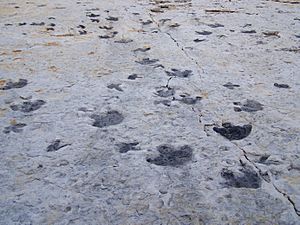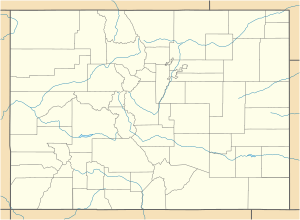Dinosaur Ridge facts for kids
Quick facts for kids Dinosaur Ridge |
|
|---|---|

Tracks on Dinosaur Ridge
|
|
| Location | Dinosaur Ridge, part of the Golden-Morrison Fossil Areas National Natural Landmark, Jefferson County, Colorado, United States |
| Coordinates | 39°40′33″N 105°11′36″W / 39.6757°N 105.1934°W |
| Part of | Dakota Hogback |
| Geology | Ridge |
| Age | Cretaceous and Jurassic |
Dinosaur Ridge is a special place in Colorado, just west of Denver. It's part of a longer ridge called the Dakota Hogback. This area is famous because it holds amazing clues about dinosaurs and ancient life. It's so important that it's a National Natural Landmark called the Morrison-Golden Fossil Areas.
Back in 1877, a teacher named Arthur Lakes and a retired naval officer, Henry Beckwith, found the very first dinosaur fossils here. These fossils were from the Morrison Formation rocks. Soon after, scientists started digging, and they found the first-ever Stegosaurus bones! Other famous dinosaurs like Apatosaurus, Camarasaurus, Diplodocus, and Allosaurus were also discovered here.
In 1973, Dinosaur Ridge became a National Natural Landmark to protect its incredible history. Later, in 2011, it joined with other nearby fossil sites to form the larger Morrison-Golden Fossil Areas. A group called the Friends of Dinosaur Ridge was started in 1989. They help protect the site and teach people all about its amazing fossils.
Contents
Dinosaur Discoveries and Ancient Worlds
Dinosaur Ridge tells two main stories about ancient times, shown in its different rock layers.
Jurassic Period: Dinosaur Bones
On the west side of Dinosaur Ridge, you'll find rocks from the Jurassic Period. These rocks are part of the Morrison Formation. This is where Arthur Lakes made his big discovery in 1877. Scientists have dug up many dinosaur bones here, including those of huge plant-eaters and fierce meat-eaters. They've also found fossils of ancient turtles and lungfish, showing a diverse prehistoric world.
Cretaceous Period: Dinosaur Tracks
The rocks on the east side of Dinosaur Ridge are from the Cretaceous Period. These are part of the Dakota Formation. In 1937, workers building Alameda Parkway found dinosaur footprints here! Over time, more tracks were carefully uncovered. Most of these tracks were made by plant-eating dinosaurs, like Iguanodon or Eolambia. You can also see tracks from bird-like dinosaurs, crocodiles, and large meat-eating dinosaurs called theropods.
Exploring Dinosaur Ridge Today
Dinosaur Ridge is like an outdoor museum where you can learn a lot. You can take guided bus tours or walk along the trails. There are signs that explain the geology (how the earth is made) and paleontology (the study of fossils). You can also visit a small Exhibit Hall, a Discovery Center, and a gift shop.
The Dinosaur Ridge Trail Experience
The main trail follows a paved road that's closed to regular cars. It climbs about 700 feet (213 meters) and is about 2 miles (3.2 km) round-trip. It usually takes 1.5 to 2 hours to walk. Along the way, you'll find many interesting stops:
- Exhibit Hall and Main Visitor Center: This is where your adventure often begins, offering displays and information.
- Ancient Seaway Shoreline: Long ago, during the Cretaceous Period, a huge ocean called the Western Interior Seaway covered this area. The Dakota Sandstone layers you see were once the sandy shore of this ancient sea.
- Ripple Marks: Look closely at the rocks and you might see wavy patterns called ripple marks. These formed on the sandy bottom of the ancient sea or rivers from the movement of water.
- Slimy Beach: Imagine a muddy, sandy beach covered in a mat of tiny living things (microorganisms). This "slimy beach" was sometimes flooded by very high tides. When dinosaurs walked across it, their footprints left marks that later filled with sediment and became fossils.
- Dinosaur Tracks: This is one of the most exciting stops! You can see real dinosaur footprints. Scientists can learn a lot from these tracks, like how big the dinosaurs were, how they walked, and even if they traveled in groups. Some tracks here show large and small prints together, which might mean adult dinosaurs were caring for their young.
- Trace Fossils: Besides footprints, you'll see other "trace fossils." These aren't bones, but signs of ancient life, like the burrows of animals or the marks left by marine plants in the rock.
- Ecology of the Hogback: Dinosaur Ridge is a special "transition zone" between the Rocky Mountains and the High Plains. This means you can find plants and animals from both areas living here, like mule deer, junipers, and scrub jays. In spring, many raptors (birds of prey) fly north along the ridge.
- What is a Hogback?: The term "hogback" describes a long, narrow ridge with steep sides, like the back of a razorback hog. It forms when a hard layer of rock, like the Dakota sandstone here, resists erosion while softer rocks around it wear away.
- Volcanic Ash Bed: You can spot a white layer of volcanic ash among the sandstone. Scientists have dated this ash to about 104.6 million years ago, confirming the age of the Cretaceous rocks and the fossils found within them. This ash came from volcanoes far to the west.
- Dinosaur Bulges: These are really cool! They are the "undersides" of footprints. Imagine a dinosaur stepping in soft mud. Then, more mud fills the print. Over millions of years, these layers turn to rock. When the rock erodes, the filled-in footprint sticks out as a bulge. You can see bulges from large plant-eating sauropods and smaller plant-eaters here.
- Theropod Track: This track was moved from its original spot during road construction in 1937. It was made by a meat-eating theropod dinosaur, possibly a young Allosaurus, which was about 11.5 feet (3.5 meters) tall!
- Dinosaur Bone Quarry: This area is where many dinosaur bones were found. The bones are often rusty brown and smooth. Scientists have found ribs, vertebrae, leg bones, and teeth from dinosaurs like Stegosaurus, Apatosaurus, Camarasaurus, and Allosaurus, along with turtle and lungfish fossils. These bones were deposited in a bend of an ancient, fast-moving stream.




